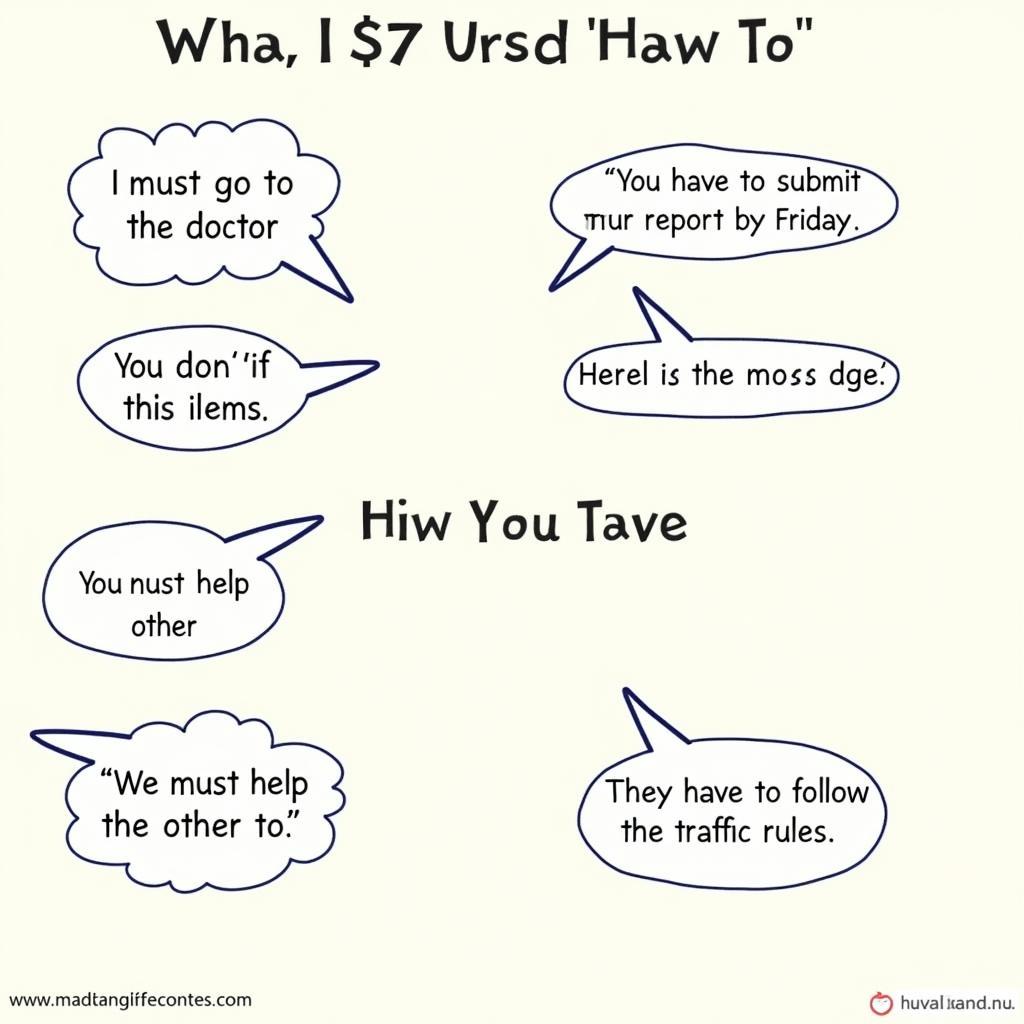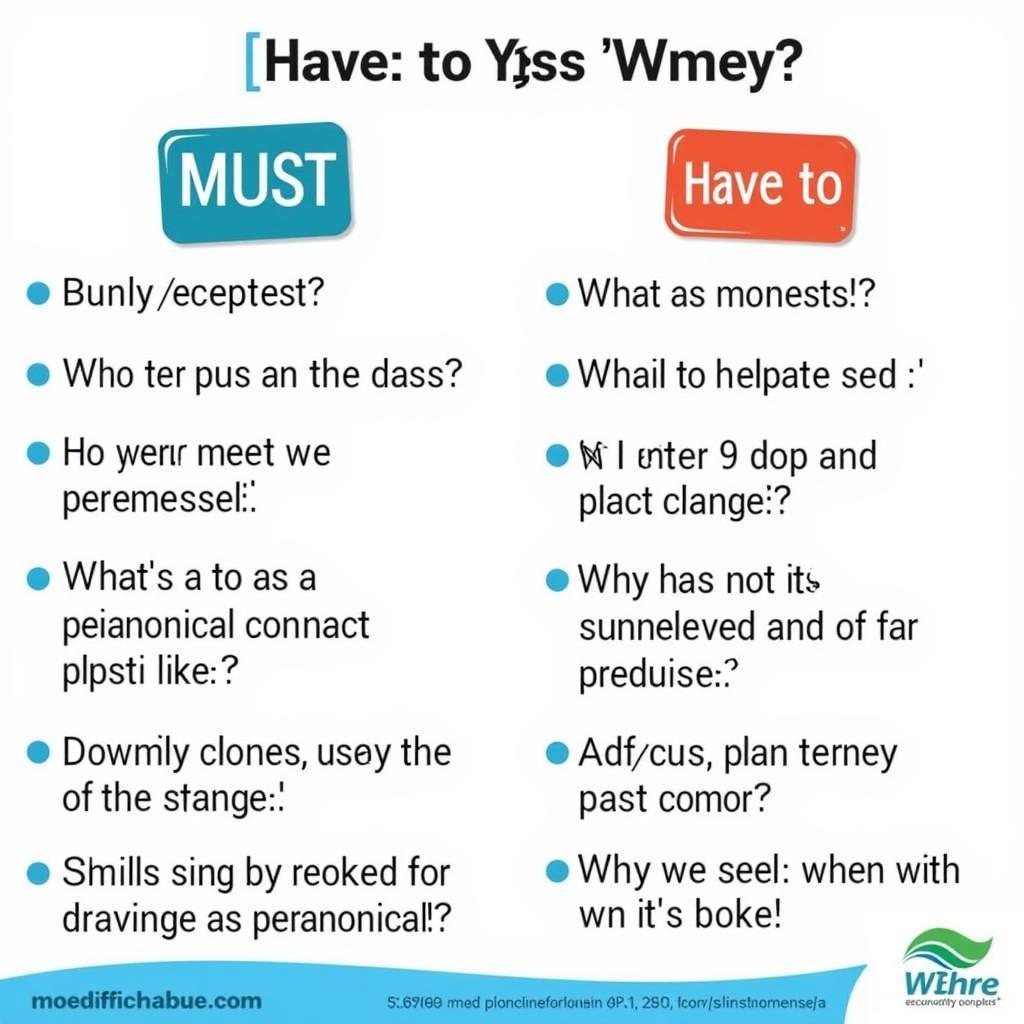“Have to” vs. “must” – these two seemingly similar modal verbs often cause confusion for English learners. Understanding the subtle yet significant differences between them is crucial for expressing obligation and necessity accurately. This guide delves into the nuances of “have to” and “must,” providing clear explanations, practical examples, and helpful tips to ensure you use them correctly.
External vs. Internal Obligation: The Core Difference
The primary distinction between “have to” and “must” lies in the source of the obligation. “Have to” expresses external obligation – rules imposed by others or circumstances beyond your control. “Must,” on the other hand, conveys internal obligation – a sense of duty or necessity stemming from personal conviction. For example, “I have to wear a uniform to school” (school rule) versus “I must study hard for this exam” (personal decision). This core difference influences how we use these verbs in various contexts.
 Sử Dụng Must và Have To Trong Câu
Sử Dụng Must và Have To Trong Câu
“Have To” in Detail: External Rules and Regulations
“Have to” is your go-to verb when discussing obligations imposed by external factors. Think laws, regulations, workplace requirements, or even social expectations. “We have to pay our taxes,” “She has to attend the meeting,” and “They have to be quiet in the library” are all examples of externally enforced obligations. online classes vs traditional classes often have different sets of requirements. Note that “have to” can be used in various tenses, including past and future, reflecting the ongoing nature of external rules. For instance, “I had to work late yesterday” or “We will have to submit the report next week.”
When to Use “Have to” in Questions and Negatives
Forming questions and negatives with “have to” requires the use of auxiliary verbs, such as “do,” “does,” or “did.” For example, “Do you have to leave so soon?” or “I don’t have to go to work tomorrow.” This is different from “must,” which forms negatives and questions without an auxiliary verb.
“Must” in Detail: Internal Drive and Strong Conviction
“Must” expresses a strong internal obligation or necessity driven by personal belief or a sense of duty. You use it when you feel compelled to do something based on your own judgment. “I must tell the truth,” “We must protect the environment,” or “He must apologize for his behavior” are all examples of actions driven by internal conviction. The sense of urgency and personal responsibility associated with “must” makes it a powerful tool for conveying strong feelings.
Negation of “Must”: Prohibition vs. Lack of Necessity
The negative form of “must,” “must not” or “mustn’t,” expresses prohibition. It means something is forbidden or strongly discouraged. “You must not smoke here” indicates a strict rule against smoking. However, to express a lack of necessity or obligation, we use “don’t have to.” “You don’t have to come if you don’t want to” means there’s no obligation to attend.
 Các Trường Hợp Đặc Biệt Của Must và Have To
Các Trường Hợp Đặc Biệt Của Must và Have To
“Have To” vs. “Must”: A Quick Comparison Table
| Feature | Have To | Must |
|---|---|---|
| Source of Obligation | External | Internal |
| Strength of Obligation | Varies | Generally strong |
| Questions/Negatives | Uses auxiliary verbs | Does not use auxiliary verbs |
| Past Tense | Had to | Had to (obligation), must have (past deduction) |
| Future Tense | Will have to | Must (future obligation, less common) |
Using “Have To” and “Must” in Everyday Conversations
Understanding the nuances of “have to” and “must” allows for more precise and effective communication. Imagine you’re discussing a work project. You might say, “We have to finish this by Friday” (deadline imposed by the boss) and also, “I must remember to email the client” (personal reminder). These two sentences convey different types of obligations, reflecting the complex interplay of external rules and internal motivations in our daily lives. must vs have to is a helpful resource to further clarify these distinctions.
Conclusion: Mastering the Nuances of Obligation
Mastering the difference between “have to” and “must” is essential for clear and accurate communication in English. By understanding the source and strength of obligation each verb conveys, you can express yourself more effectively in various situations. Remember, “have to” is for external rules, while “must” is for internal conviction. federal vs supreme court also highlights distinctions in legal contexts, much like “have to” and “must” do in grammar. Continuing to practice and apply these principles will enhance your fluency and accuracy. play plants vs zombies 3 requires understanding the rules of the game, similar to mastering “have to” and “must”.
FAQ
- Can I use “must” to talk about past obligations?
- Is there a difference between “must not” and “don’t have to”?
- When is it appropriate to use “must” in the future tense?
- How can I remember the difference between “have to” and “must”?
- Are there any exceptions to the rules for using “have to” and “must”?
- Can I use “must” to give strong advice?
- How does the use of “have to” and “must” change in formal vs. informal English?
Situations Where You Might Encounter This Question
- Learning English as a second language
- Writing formal emails or letters
- Preparing for an English proficiency test
- Explaining the difference to someone else
- Proofreading or editing written work
Related Articles
- Other articles on modal verbs
- Grammar guides for English learners
- Articles on English usage and style
Khi cần hỗ trợ hãy liên hệ Số Điện Thoại: 02838172459, Email: [email protected] Hoặc đến địa chỉ: 596 Đ. Hậu Giang, P.12, Quận 6, Hồ Chí Minh 70000, Việt Nam. Chúng tôi có đội ngũ chăm sóc khách hàng 24/7.